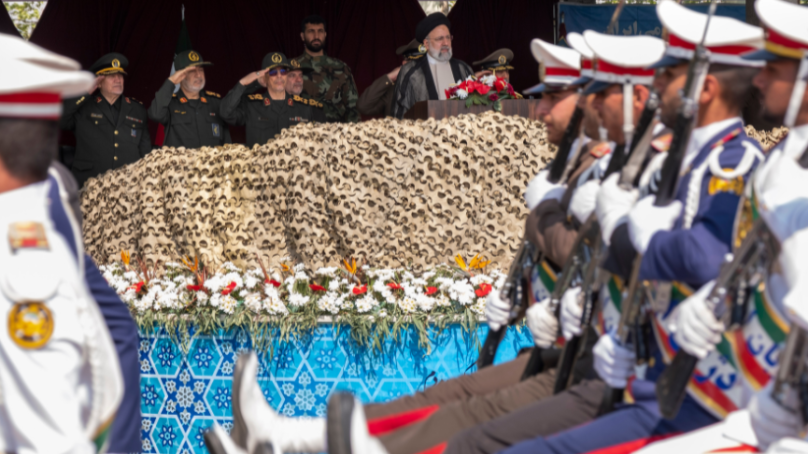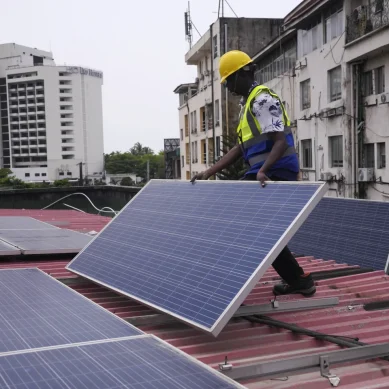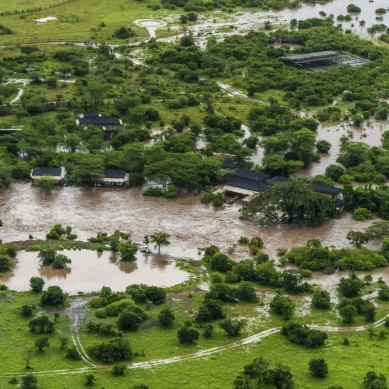
How Israel retaliates could set the tone of conflict in the Middle East for years to come. Tel Aviv could return to a sub-threshold level of battling Tehran or take the two countries down a road to all-out war.
The tit-for-tat retaliation cycle between Israel and Iran has entered a new phase, exiting a period of shadow conflict and heading into one of more open state-on-state violence. This represents a dangerous moment for their military standoff, and the Middle East more widely, as old norms are torn up and new ones are yet to be agreed, implicitly or explicitly.
After Iran’s 14 April missile and uninhabited aerial vehicle (UAV) attacks on Israel, Itamar Ben-Gvir, the Israeli national security minister, called for a ‘crushing attack’ on Iran. He argued that ‘the concepts of containment and proportionality are concepts that passed away on October 7’, the day Hamas, an Iranian proxy force, mounted its assault on Israel, killing around 1,200 people. Invoking a link between escalation dominance and deterrence, he stated that ‘in order to create deterrence in the Middle East, the landlord must go crazy’.
How Israel responds, if at all, will be critical to determining if the era of Tel Aviv and Tehran acting subtly in their interstate conflict is over and a hot-war period has begun.
Ben-Gvir’s comments, whether serious or posturing, indicate that the tenor of the discussion, as well as the reality of the conflict, have shifted. Both the Hamas attacks and the Iranian UAV and missile assault, largely staged by the Islamic Revolutionary Guard Corps (IRGC), represented a significant departure in the rules and norms by which the Middle East’s conflict was being fought.
Israel’s targeting of the Iranian consulate in Damascus on April 1 has been widely regarded as a step up in its openness to hit at Iran directly, though Tehran is accused of targeting an Israeli embassy in the past.
The recent behaviour is a departure from the past when either party often tried to shroud their actions in the cloak of plausible (or sometimes implausible) deniability. On the Israeli side, such actions included assassinations of scientists involved in Iran’s nuclear programme and the Stuxnet cyber-attack on nuclear weapons facilities. On the Iranian side, such actions largely involved the reliance on proxies to keep direct involvement in attacks at an arm’s-length distance.
The transition from those old patterns to new ways of operating brings with it a window of heightened danger, as both sides test the other’s red lines. The chance of escalation is compounded by hawkish voices on either side that appear to be gaining traction.
In times of fear and flux, those who offer strength and simplicity in their solutions for complex issues often gain popularity, as evidenced by a century of ebb and flow of populism in the West and elsewhere.
The online defence database from the IISS, delivering authoritative and searchable defence data and insights into military capabilities, policy priorities and commercial opportunities in more than 170 countries.
The belief that a demonstration of disproportionate strength is the only way to ensure deterrence, as embodied by hawks in Jerusalem and Tehran, risks the confrontation entering an unending cycle of violence. There is a fine line between being robust and behaving so provocatively that the adversary sees no space to de-escalate without losing face.
A similar shift in dynamics occurred with Russia’s 2022 full-scale invasion of Ukraine. The blatant use of force tore up the playbook Moscow had used before, for instance, in Georgia and Crimea, characterised by unconventional, hybrid tactics. It served as a watershed moment in the West’s relationship with Russia, moving from a sub-threshold level of conflict with a Western partner to overt conventional military action. It has also brought Russia and the West more directly into conflict, even if Kyiv’s allies are keeping guardrails on their support to placate Moscow.
Western governments are struggling to decide how much more direct support to offer Kyiv, with some talking of ‘boots on the ground’, which the Kremlin has described as a ‘red line’ to open conflict with the West. Russia has blinked, though, on earlier ‘red lines’, so the question in Ukraine, as in the Middle East, is how far one side is willing to push the other.
Western and some Middle Eastern countries are hoping Israel may ‘take the win’ given the success it and its allies had in downing Iranian missiles and UAVs, effectively embarrassing the IRGC along the way. Global leaders are also trying to restrain Israel from further retaliation.
United States President Joe Biden, while supportive of Israel, has said that the American military would not participate in a retaliatory attack on Iran. French President Emmanuel Macron has encouraged isolation over escalation, and British Foreign Minister David Cameron also has signalled that the UK would not be involved in any response by Israel.
Israel has several options. It could, as some allies hope, claim strategic victory. Or it could resort to the old ways of retaliating by deferring action to a later point and going after IRGC targets in a more clandestine way.
The Netanyahu government’s appetite for such an approach is uncertain, though, given its propensity to lean heavily on demonstrating an ability to use military force on a large scale. But the decisions Tel Aviv takes now are likely to set the tone for the next round of conflict.
- A Tell report / By Callum Fraser, Chief of the General Staffs British Army











